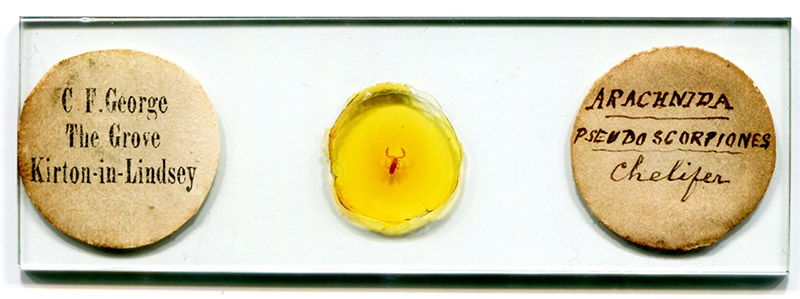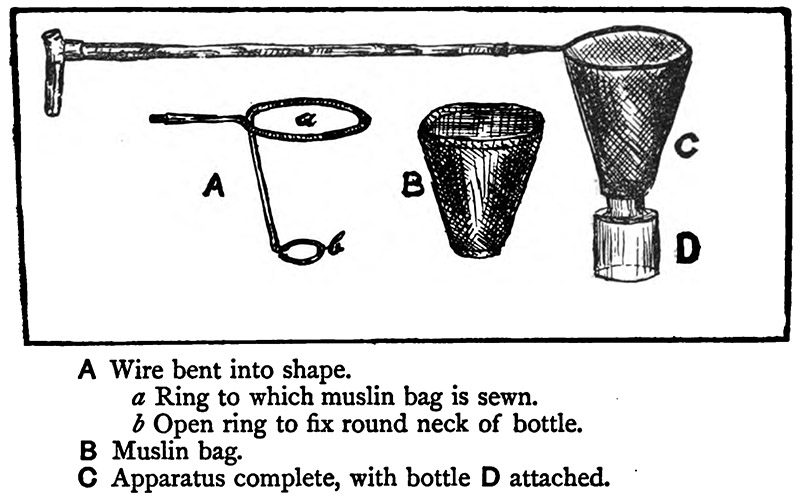Charles Frederick George, 1833 - 1923
by Brian Stevenson
last updated February, 2022
C.F. George was a physician and surgeon in Kirton-in-Lindsey, Lincolnshire, as was his father before him, and a son afterward.
From the 1870s onward, he became a noted entomologist. Specializing in arachnids, especially water mites, he was a close colleague of other well-regarded mite experts such as Albert D. Michael (1836-1927) and Edwin Bostock (1838-1901). George published extensively in popular scientific magazines of his time.
George was also an accomplished microscopist. He was a member of the Quekett Microscopical Club and the Postal Microscopical Society, and served as President of the PMS in 1885.

Figure 1.
A microscope slide that was prepared by Charles F. George. He advertised to exchange mounts of pseudoscorpions during 1874. The address on the label dates this slide from around that time – he moved from "The Grove" to another home, "Belle Vue", during 1880-1881.

Figure 2.
Figure 2. Photomicrographs of the pseudoscorpion in the George slide shown in Figure 1. Both photographed with a 3.5x objective lens and C-mounted digital SLR camera on a Leitz Ortholux II. Left image taken with transmitted brightfield lighting. Right image taken with transmitted lighting and the specimen between crossed polarizing filters.

Figure 3.
An undated photograph of C.F. George. Adapted for educational, nonprofit purposes.
Charles Frederick George was born during 1833 in Kirton-in-Lindsey (baptised on September 7, 1833), to Henry and Ann George. Father Henry was a local physician. As a young man, Charles evidently studied medicine under his father, with the 1851 national census listing Charles as living with his parents and working as a "Surgeon (apprentice)". He later attended medical school in London. He was the Saint Thomas's Hospital Cheselden Medalist for 1856-57 (awarded to the top fourth year surgeon). In 1857, he received his Member of the Royal College of Surgeons of England, Licentiate of Medicine, and Licentiate of the Society of Apothecaries of London.
Charles returned to Kirton-in-Lindsey, and married Mary Ann Poynter on November 25, 1858. In 1866, he was appointed "Medical Officer for the borough District of the Gainsborough Union, and the Kirton District the Glanford Brigg Union, Lincolnshire".
The earliest record that I located of George as a microscopist is an 1872 exchange offer from Hardwicke's Science-Gossip, "For Hematopinus suis (Pig Louse) and Polyrenus Lagurus (Pencil-tail), unmounted, send well-mounted object of interest to C.F. George, Kirton Lindsey, Lincolnshire."
In 1874, he offered to exchange, "Obisium trombidioides, for other Chelifers, alive or well mounted.-C. F. George, The Grove, Kirton Lindsey". The microscope slide of a chelifer (pseudoscorpion) shown in Figures 1-2, above, probably dates from this time. His statement to provide "well-mounted" slides implies that he was a competent slide-maker by this time.
George's first major publication was "On 'The Blyborough Tick' (Argas fischerii)", published in The Journal of the Quekett Microscopical Club.
Another major work, "A contribution to the knowledge of British Oribatidae", by "By A.D. Michael, F.R.M.S., with the assistance of C.F. George, M.R.C.S.E. (of Kirton Lindsey)" was published in The Journal of the Royal Microscopical Society in 1879.
C.F. George joined the Quekett Microscopical Club on June 25, 1880. He ceased his membership at the end of 1887. He joined the Postal Microscopical Society in February, 1881. George served as the Society's President in 1885. His Presidential Address was entitled "Mites".
In early 1880, George published an exchange request that gave the name of his home, "Wanted, the 'Entomologist' for September, 1879, No. 196, also the other numbers up to the present time, for microscopic slides or cash. C. F. George, The Grove, Kirton Lindsey". The 1882 list of members of the PMS gave George's address as "Belle Vue House". That move can help identify the production dates of George's microscope slides.
During 1881, he published two articles in Hardwicke's Science Gossip, "On British freshwater mites" and "Arrhenurus perforates - a new water-mite".
The following year, he described the home-made apparatus that he used for collecting water mites and other aquatic animals. Figure 4 shows George's original illustration. "I should be glad for you to publish in your Journal, if you think it worth while, the following description of a piece of apparatus, which I have found very useful in fishing for microscopic objects in water. I have used it chiefly in searching for Hydrachnidae, and so far have found no other piece of apparatus so efficient for that purpose; it can, moreover, be easily manufactured by anyone for his own use. Obtain a piece of thick brass wire, and at about 6 inches from one end bend it into a ring 4 or 5 inches in diameter. After connecting with some finer wire the two extremities of the ring, bend the stout wire at right angles to the ring and continue it for about 4 inches. Then make another ring about it inches in diameter, and there terminate the wire, leaving the smaller ring, however, not quite complete. The two rings will thus be parallel to each other. On the upper ring stitch a piece of tape, and to this sew a piece of muslin, made in the shape of a conical bag, and having its wider end affixed to the tape. Into the lower opening of this bag a small, wide-mouthed glass bottle, of about two ounces capacity, should be fastened by a piece of thread or fine string, and the lower ring is then sprung round the neck of the bottle. The other end of the brass wire, which was left projecting for about 6 inches, is now to be firmly lashed to a light cane or stick, and your apparatus is complete. In order to use the apparatus, move it gently backwards and forwards on the surface of the water, under the surface, or just above the bottom of the pond, and among the weeds; the muslin will allow the water to pass through it, whilst any living organisms will be retained by the bottle. This can from time to time be examined with a pocket-lens, and when it is found to contain game, the lower ring of wire can be slipped off, and the neck of the bottle pushed up through the upper ring, thus inverting the net. The contents may thus be poured off into another bottle, and after re-arranging the apparatus, fishing may go on again. The object of the piece of wire connecting the two ends of the net is to keep all stiff, so that the bottle can be turned in any direction and yet both the upper and lower mouths of the net will remain open. A trial of this simple apparatus will, I think, satisfy all microscopic collectors of its great utility."
Another article by C.F. George might also be of value to modern microscopists: "Mite from Gamasus Coleoptratorum, taken from Humble-Bee. An account of this mite, with figures, will be found in 'Science Gossip', 1879, p. 81. Since that article was written, I have tried another plan for finding them without killing the bee. Having caught your bee, place it under a wine-glass; then moisten a bit of blotting-paper with a drop or two of chloroform, and introduce it under the glass. Before the bee is perfectly stupified the Gamasi will quit it, and may be picked up with a damp brush, and placed in the live-box or hollow slip; whilst the bee, if put in the sun, will recover and fly away relieved of its parasitic companions. My friend, Mr. Michael, had some Gamasi obtained from a Humble-Bee preserved in spirit, and he tells me that after he had seen me he examined them, and found the mite. I do not think the mite is a Hypopus; indeed, I think it requires a new name, (if it be not altogether a new genus,) but perhaps time and patience will clear up this matter". (the mites are of the genus Parasitellus, and feed on pollen rather than the bee itself).
Charles' wife, Mary Ann, died on December 14, 1886. One or more of his unmarried daughters remained with Charles in the family home. The 1911 national census listed 77 year-old Charles George as living with daughter Mary, a nurse, and two domestic servants. Charles Fredrick George died on November 11, 1923.

Figure 4.
Charles F. George's original illustration of his "water collecting apparatus", described in "The Journal of the Postal Microscopical Society", 1882.
Resources
England census and other records, accessed through ancestry.com
George, C.F. (1876) On "The Blyborough Tick" (Argas fischerii), Journal of the Quekett Microscopical Club, pages 223-225
George, C.F. (1881) On British freshwater mites, Hardwicke's Science-Gossip, pages 193-194
George, C.F. (1881) Arrhenurus perforates – a new water-mite, Hardwicke's Science-Gossip, page 269
George, C.F. (1881) Water collecting apparatus, Journal of the Postal Microscopical Society, pages 158-160
George, C.F. (1883) On the palpi of fresh-water mites as aids to distinguishing sub-families, Journal of Microscopy and Natural Science, pages 73-75
George, C.F. (1883) Trichodectes scalaris, Journal of Microscopy and Natural Science, page 121
George, C.F. (1883) Haematopinus from the horse, Journal of Microscopy and Natural Science, page 122
George, C.F. (1883) Odynerus, posterior portion of Abdomen of, Journal of Microscopy and Natural Science, page 124-125
George, C.F. (1883) Mite from Gamasus Coleoptratorum, Journal of Microscopy and Natural Science, pages 244
George, C.F. (1884) White mites, Journal of Microscopy and Natural Science, pages 42-43
George, C.F. (1884) Mite from Pheasant, Journal of Microscopy and Natural Science, page 42
George, C.F. (1884) On the palpi of fresh-water mites as aids to distinguishing sub-families, second paper, Journal of Microscopy and Natural Science, pages 91-92
George, C.F. (1884) Presidential Address to Postal Microscopical Society, Journal of Microscopy and Natural Science, pages 1-5
George, C.F. (1886) Bees, Journal of Microscopy and Natural Science, pages 243-245
George, C.F. (1888) Aculeate Hymenoptera in North Lincolnshire, The Naturalist, page 107
George, C.F. (1897) British freshwater mites, Science-Gossip, New series, Vol. 3, page 264
George, C.F. (1900) Arrenurus ornatus, Science-Gossip, New series, Vol. 7, pages 204-205
George, C.F. (1900) British freshwater mites, Science-Gossip, New series, Vol. 7, pages 230-231 and 293-295
Hardwicke's Science-Gossip (1872) Exchange offer from C.F. George, page 120
Hardwicke's Science-Gossip (1874) Exchange offer from C.F. George, page 240
Hardwicke's Science-Gossip (1880) Exchange offer from C.F. George, page 24
Journal of the Postal Microscopical Society (1882) Members, Vol. 1, page 12
Journal of the Quekett Microscopical Club (1882) Members
Journal of the Quekett Microscopical Club (1887) Members
Journal of the Quekett Microscopical Club (1888) Members
Kirton-in-Lindsey since 1860 (1988) Scunthorpe Museum Society
The Lancet (1866) C.F. George, M.R.C.S.E, page 218
The Medical Directory (1873) George, Charles F., page 431
Michael, A.D., and C.F. George (1879) A contribution to the knowledge of British Oribatidae, Journal of the Royal Microscopical Society, pages 225-251
Probate of the will of C.F. George (1923) "George Charles Frederick of Kirton-in-Lindsey Lincolnshire died 11 November 1923 Probate Lincoln 13 December to England Howlett solicitor the reverent Walter Lewty clerk in holy orders and John Moore solicitor's clerk. Effects £26353 19s", accessed through ancestry.com
Saint Thomas's Hospital Reports (1903) Cheselden Medalists, Vol. 30, page 71



